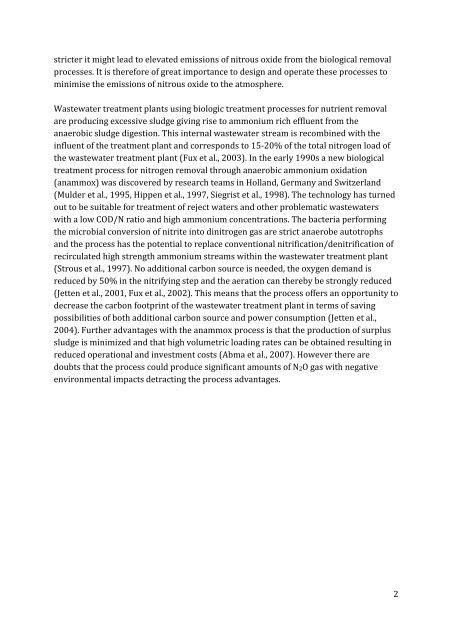N2O production in a single stage nitritation/anammox MBBR process
N2O production in a single stage nitritation/anammox MBBR process
N2O production in a single stage nitritation/anammox MBBR process
Create successful ePaper yourself
Turn your PDF publications into a flip-book with our unique Google optimized e-Paper software.
stricter it might lead to elevated emissions of nitrous oxide from the biological removal<br />
<strong>process</strong>es. It is therefore of great importance to design and operate these <strong>process</strong>es to<br />
m<strong>in</strong>imise the emissions of nitrous oxide to the atmosphere.<br />
Wastewater treatment plants us<strong>in</strong>g biologic treatment <strong>process</strong>es for nutrient removal<br />
are produc<strong>in</strong>g excessive sludge giv<strong>in</strong>g rise to ammonium rich effluent from the<br />
anaerobic sludge digestion. This <strong>in</strong>ternal wastewater stream is recomb<strong>in</strong>ed with the<br />
<strong>in</strong>fluent of the treatment plant and corresponds to 15-20% of the total nitrogen load of<br />
the wastewater treatment plant (Fux et al., 2003). In the early 1990s a new biological<br />
treatment <strong>process</strong> for nitrogen removal through anaerobic ammonium oxidation<br />
(<strong>anammox</strong>) was discovered by research teams <strong>in</strong> Holland, Germany and Switzerland<br />
(Mulder et al., 1995, Hippen et al., 1997, Siegrist et al., 1998). The technology has turned<br />
out to be suitable for treatment of reject waters and other problematic wastewaters<br />
with a low COD/N ratio and high ammonium concentrations. The bacteria perform<strong>in</strong>g<br />
the microbial conversion of nitrite <strong>in</strong>to d<strong>in</strong>itrogen gas are strict anaerobe autotrophs<br />
and the <strong>process</strong> has the potential to replace conventional nitrification/denitrification of<br />
recirculated high strength ammonium streams with<strong>in</strong> the wastewater treatment plant<br />
(Strous et al., 1997). No additional carbon source is needed, the oxygen demand is<br />
reduced by 50% <strong>in</strong> the nitrify<strong>in</strong>g step and the aeration can thereby be strongly reduced<br />
(Jetten et al., 2001, Fux et al., 2002). This means that the <strong>process</strong> offers an opportunity to<br />
decrease the carbon footpr<strong>in</strong>t of the wastewater treatment plant <strong>in</strong> terms of sav<strong>in</strong>g<br />
possibilities of both additional carbon source and power consumption (Jetten et al.,<br />
2004). Further advantages with the <strong>anammox</strong> <strong>process</strong> is that the <strong>production</strong> of surplus<br />
sludge is m<strong>in</strong>imized and that high volumetric load<strong>in</strong>g rates can be obta<strong>in</strong>ed result<strong>in</strong>g <strong>in</strong><br />
reduced operational and <strong>in</strong>vestment costs (Abma et al., 2007). However there are<br />
doubts that the <strong>process</strong> could produce significant amounts of <strong>N2O</strong> gas with negative<br />
environmental impacts detract<strong>in</strong>g the <strong>process</strong> advantages.<br />
2















